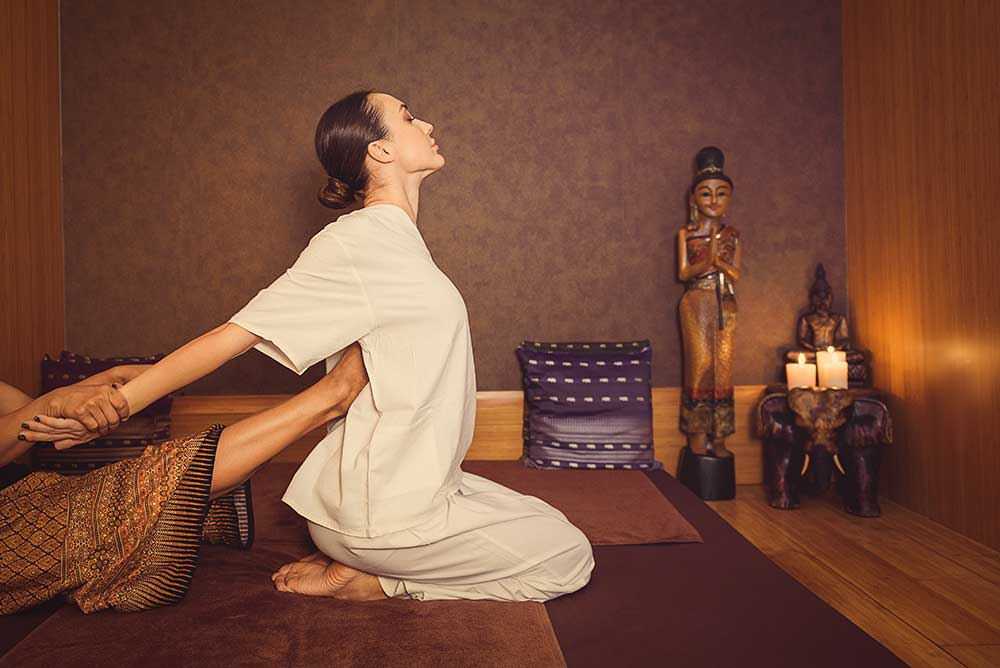
Wondering whether you’d do better with a yoga class or a massage?
Thai massage can provide the best of both worlds, leaving you feeling calm and blissfully relaxed – while also knowing you’ve just improved your whole body flexibility.
Thai massage is an ancient form of healing that utilizes yoga-like stretches during the massage session.
It’s a unique and adventurous massage technique, and if you go in expecting a traditional hands-only Swedish technique, you’ll be surprised.
Developed in India thousands of years ago as a way to promote healing from the inside out, Thai massage aims to restore positive energy flow throughout the body by incorporating stretching along with massage.
How does Thai massage work?
Thai Massage therapists apply pressure to tense muscles by using their body weight to move your body around, stretching and massaging muscles at the same time. No traditional massage table is involved, as both you and the massage therapist are positioned on a padded mat.
Therapists typically do not use lotion or oil during Thai massage to avoid slipping out of the stretching positions.
What if I’m not very flexible?
Then you’re the perfect candidate!
Thai massage may be particularly beneficial to active individuals and/or athletes who are regularly stressing their muscles and would benefit from additional stretching to help improve range of motion, balance and flexibility. But even a moderately active individual can benefit from increased flexibility.
What can I expect from a Thai massage?
Since Thai massage involves stretching and putting your body into a variety of positions – along with that of the practitioner, it is not a traditional spa massage setup with sheets on a massage table.
Think of Thai massage as more of a dance between you and the provider, where the provider is the lead and manipulates your body, often using their own body weight to exaggerate stretches on large muscle groups.
Dress in loose-fitting clothing to allow for comfort and modesty as the massage therapist moves your body into the stretching positions and remember that your thai massage therapist can decrease or increase the intensity of each stretch based on your body’s capability and your comfort level. (you just need to share what your body’s feeling consistently)
Let your massage therapist know if you would like a different level of intensity – or if a particular stretch is uncomfortable. Contrary to the way many feel, Thai practitioners truly want steady feedback from their clients and use this to refine their technique to provide sessions uniquely tailored to each individual.
Want to see what Thai massage looks like in action?
If you can’t quite picture a Thai massage, or if you would like to hear from someone who has tried it, here is a link to a great demonstration video to see exactly what it is.
Ready to give Thai massage a try?
Locate the best Thai massage therapists near you using the nationwide MassageBook directory of massage and bodywork providers. The website makes it easy to search highly rated professional massage therapists and businesses that offer specialty techniques like Thai massage. Once you find one you like, you can even check availability and book an appointment online!






Great information in your blog. thanks for sharing
Thai massage is beneficial to those who are really Active or athlete. Those who are regularly stretching their muscles can improve range of motion, balance and flexibility with massage therapy.
I’m a massage therapist and I had my 1st Thai Massage last week in Chicago. It wasn’t on a table. A traditional Thai massage in on a thick mat in the floor. The mat itself was comfortable. My problem was that it hurt my neck to turn my head all the way to one side or the other while the therapist worked on my back. Putting my face straight into the mat meant I couldnt breathe. Until I turned over, it was very uncomfortable. I won’t try it again for that reason.
Excellent information. It is really a great help. Thanks alot for the article.